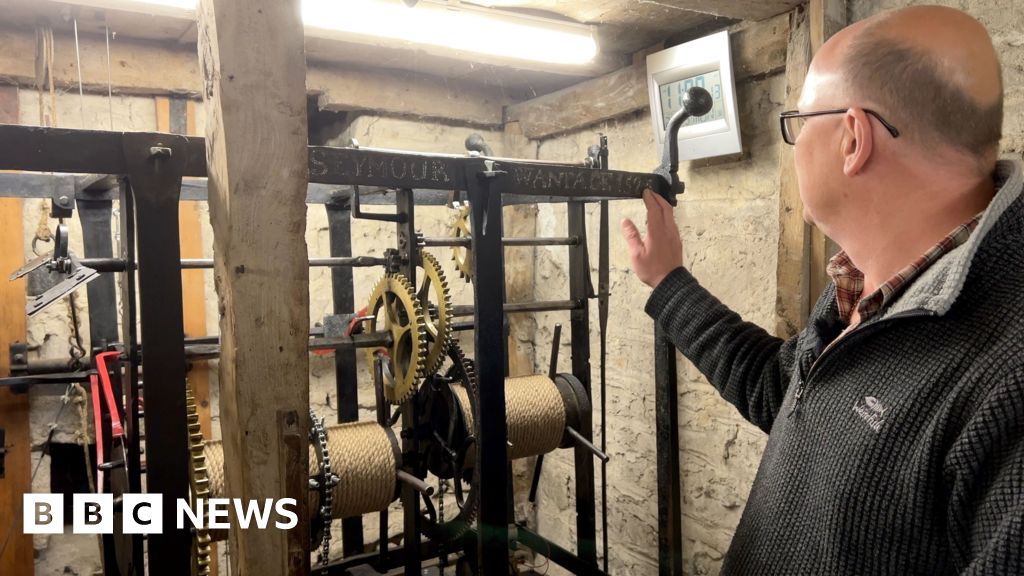How ICE Is Seeking to Ramp Up Deportations Through Courthouse Arrests


Officials had largely steered clear of arrests at immigration courts out of concern that they would deter people from showing up for hearings. A hearing on Tuesday at immigration court in Van Nuys, Calif., was supposed to be routine for a young family from Colombia, the first step in what they hoped would be a successful bid for asylum. To their surprise, the judge informed the father, Andres Roballo, that the government wished to dismiss his deportation case. Taken aback, Mr. Roballo hesitated, then responded: “As long as I stay with my family.” Moments later, as they exited the courtroom into a waiting area, Mr. Roballo was encircled by plainclothes federal agents who ushered him into a side room. Other agents guided his shaken wife, Luisa Bernal, and their toddler toward the elevator. Outside the courthouse, Ms. Bernal collapsed on a bench. “They have him, they have him,” she wailed. “We didn’t understand this would happen.” Mr. Roballo’s arrest was part of an aggressive new initiative by Immigration and Customs Enforcement to detain migrants at immigration courts, the latest escalation by the Trump administration in its all-out effort to ramp up deportations. Agents have begun arresting migrants immediately after their hearings if they have been ordered deported or their cases have been dismissed, a move that enables their swift removal, according to immigration lawyers and internal documents obtained by The New York Times. The operations, which have taken place across the country in the past week, have required a high level of coordination between the government lawyers in the courtrooms and the ICE officers waiting to make the arrests, according to the documents. The tactic is a significant break from past practice, when immigration officials largely steered clear of courthouse arrests out of concern that they would deter people from complying with orders. Critics, including some former homeland security officials, say the practice is deceptive and could backfire. “Arresting people there subverts the legal process and will make others too scared to show up in the future, ultimately pushing people further into the shadows and out of legal status,” said Deborah Fleischaker, a senior ICE official during the Biden administration. “We don’t actually have an immigration process if we make it impossible for people to comply and move through the system as ours was designed,” she said. “People showing up for their immigration court hearings are by definition complying.” Federal officials say the initiative saves valuable resources, allowing Immigration and Customs Enforcement to more quickly to identify migrants who are subject to deportation rather than deploying officers to try to track down people after they leave court and often slip out of view. “If an individual is going through proceedings and he’s going to take a deportation order, then and there we want to make the arrest of that individual,” Garrett J. Ripa, a senior ICE official in Miami, said in an interview. “It’s easier on us,” he added, noting that the approach also avoided arrests in communities. When asked whether the arrests could deter people from showing up to court, Mr. Ripa said it was not clear. “I think it’s really just in the initiative stage,” he said. “So I don’t have any concrete evidence to show one way or the other.” A senior ICE official said in a statement that the agency’s prosecutors still had discretion to dismiss cases. Tricia McLaughlin, a spokeswoman for the Department of Homeland Security, added that most migrants who illegally entered the United States in the past two years were subject to expedited removals. “Biden ignored this legal fact and chose to release millions of illegal aliens, including violent criminals, into the country with a notice to appear before an immigration judge,” she said in a statement. “ICE is now following the law and placing these illegal aliens in expedited removal, as they always should have been.” The migrants being targeted in court are typically there because the federal government has initiated deportation proceedings against them for their illegal entry into the United States, not for other alleged crimes. A number of them may also be seeking asylum as a defense to deportation because they fear returning to their countries. Greg Chen, a senior director at the American Immigration Lawyers Association, said his organization had documented dozens of arrests in courthouses across 11 states and 16 cities since last week. Those detained have included migrants whose statuses have not been resolved by the courts or who have opposed efforts to dismiss their cases, lawyers said. “We are concerned that this is a form of collusion between the courts and ICE,” Mr. Chen said. “Many are eligible for asylum or other legal protections, but because the Trump administration is pressuring judges in courtrooms to dismiss the cases so that ICE can arrest and fast-track their deportation, it is depriving them of a fair hearing.” A spokeswoman for the Executive Office for Immigration Review, the agency in the Justice Department that runs the immigration courts system, declined to comment. In New York on Wednesday, ICE officers wearing face masks and carrying photographs of migrants they were seeking to arrest waited by the elevators of the courthouses in Lower Manhattan. Outside, protesters tried to block vans carrying detained migrants, leading to the arrests of 23 people. Among the migrants arrested in a Manhattan courthouse lobby was a young Venezuelan man who appeared to be the first public school student in New York City to be detained by ICE since President Trump returned to office. The student, a 20-year-old named Dylan, entered the country last year by registering through a mobile app the Biden administration had offered migrants to temporarily live and work in the United States while they applied for asylum. When he showed up for a May 21 court date, his case was dismissed. He was followed into the elevator by ICE officers, who then arrested him in the lobby, according to his mother, Raiza. “It was like a trap,” said Raiza, who spoke on the condition that her last name be withheld. Dylan’s arrest followed the new playbook. The day before, on May 20, Immigration and Customs Enforcement had circulated an internal memo instructing government prosecutors to help deportation officers with the operation, according to a copy obtained by The Times. The agency was seeking to arrest people who were either likely to be ordered deported or “amenable” to a fast-track deportation process known as expedited removal, the memo said. Expedited removal, which does not require a hearing before a judge, was a process previously reserved for migrants picked up within 100 miles of the border. The Trump administration has expanded it to apply to migrants who have been in the country for fewer than two years. If an undocumented migrant no longer has a case pending before the court, they can be subject to expedited removal. Under the new policy, Immigration and Customs Enforcement is encouraging prosecutors to look for cases that could be dismissed, which could accelerate deportations of more people, according to the internal guidance. The prosecutors were told to give ICE officers at least two days to plan for an arrest in court and to give the courts a 24-hour warning as well. Prosecutors were also instructed to give deportation officers “the exact location of the courtroom at which the alien’s hearing is being held and an estimate of the time frame for the hearing,” the memo said. Usually, having a deportation case dismissed is a positive outcome for a migrant. However, according to lawyers, judges have not been informing migrants that a dismissal can now lead to their arrest. And, in some instances, judges have agreed to dismiss cases even though migrants objected, the lawyers said. On the day the guidance was issued, Leandro B. Ferrer, an immigration lawyer, said that ICE officers ambushed him and his clients — two men from Cuba with pending asylum claims — as they left a courthouse in Phoenix. A judge had just granted a request by government lawyers to have their cases dismissed. “Naturally, as a lawyer, this is news that you want to hear: A dismissal in immigration court is equivalent to dismissing the criminal charges against a defendant in criminal court,” Mr. Ferrer said. Then ICE officers arrested his clients, who remain detained, he said. “It was a trap, nothing short of a trap,” said Mr. Ferrer, who predicted that the tactics could deter migrants from showing up in court and lead to their deportations as a result of missed hearings. Many immigration advocates said they had never seen ICE agents in court until the past week. Brittany Triggs, a lawyer in Buffalo, said she spotted them in the lobby, in the hallways near restrooms and in a waiting area. At a recent hearing, she recalled, the judge gave a Venezuelan immigrant until June 5 to respond to the government’s motion to close his case. The hearing ended, and the man left several minutes before Ms. Triggs. Later, she said, she wondered, “Oh my God, what if they arrested him anyway?” The following morning, she checked the ICE detainee locator online and found that the man was being held at a facility in Batavia, N.Y., about 45 minutes away. Immigrants who enter the United States unlawfully are usually placed in deportation proceedings and must appear in court for several hearings, even if they apply for asylum, as their cases wind through the backlogged system. The federal government has a right to detain people while they are in immigration proceedings. But after they enter the United States unlawfully and are processed at the border, immigrants are generally allowed to fight their cases while living in communities around the country. Many are not considered public security threats, and it is expensive, if impractical, to hold so many people in detention facilities. In recent days, as news rapidly circulated on social media that immigrants were being detained in court, some of them appeared to be skipping their hearings. On Tuesday in Van Nuys, a neighborhood in Los Angeles, only five of the 15 migrants who had scheduled cases reported for their hearings in Courtroom 1. One was an unaccompanied minor who had crossed the border. Another was a man who said he had lived in the United States for a long time. A Guatemalan man attended by video. The government lawyer asked the judge to dismiss the case of another immigrant, a woman in a white dress, over her objection. “I am going to dismiss your case without prejudice,” the judge, Joseph A. Weiner, told her. “You can appeal that decision if you choose to do so.” As she left the courtroom, the woman was immediately met by two agents. “Hola, come with us,” one of them said, and escorted her to the room where Mr. Roballo, the Colombian man, had been taken earlier. Sitting outside the courthouse, Mr. Roballo’s wife was inconsolable. Ms. Bernal said she could not grasp why only her husband had been arrested when they were all part of the same immigration case. (Men are frequently arrested alone, leaving their wives and children free, according to lawyers.) The couple and their daughter had crossed the border with Mexico seven months ago, she said, eventually settling in the San Fernando Valley, where they had friends. They had hoped to hire a lawyer and apply for asylum. Now, with her husband in federal custody and likely to be deported, Ms. Bernal’s emotions were raw. “They separated my family,” she said between sobs. “I don’t know what we are going to do.” Her 2-year-old daughter, Mia Sofia, stood beside her. “Papa, Papa,” she called out, her voice small but insistent as she scanned the surroundings for her father. Wesley Parnell contributed reporting from New York.
What's Your Reaction?
 Like
0
Like
0
 Dislike
0
Dislike
0
 Love
0
Love
0
 Funny
0
Funny
0
 Angry
0
Angry
0
 Sad
0
Sad
0
 Wow
0
Wow
0








































